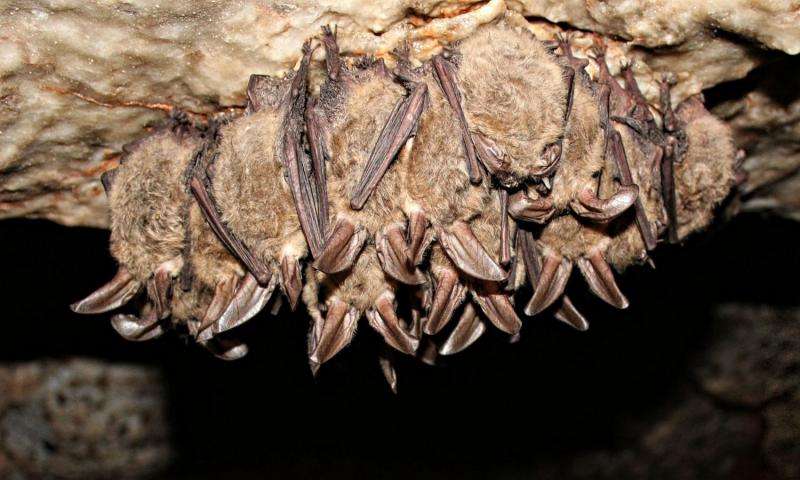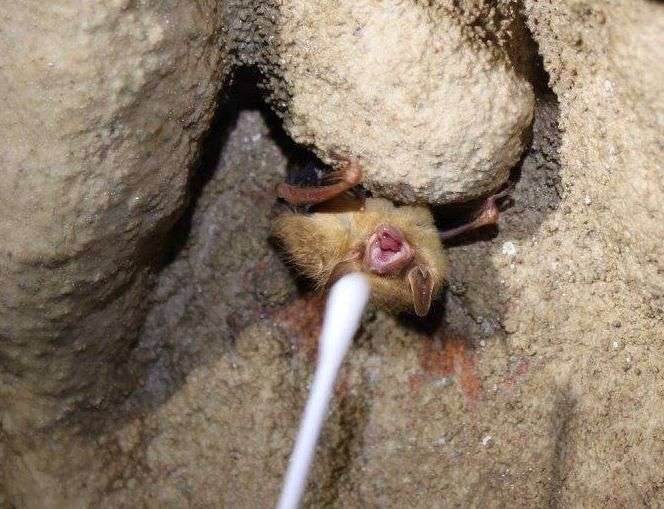Researchers address disease deadly to bats

The fungus that causes white-nose syndrome in hibernating bats has been detected on three species in the Texas counties of Childress, Collingsworth, Cottle, Hardeman, King and Scurry.
Bats play an important role in controlling insect populations that pose threats to Texas crops as well as assist in crop pollination. In 2011, the authors of the paper "Economic Importance of Bats in Agriculture" estimated the loss of bats to have a negative economic impact on U.S. agriculture of at least $3.7 billion annually. Recent studies indicate the value of insect control by bats to Texas agriculture is $1.4 billion annually, based on fewer crop losses from insects, reduced disease and less pesticide use.
The fungus was found in samples collected by a team from Texas A&M University's Institute of Renewable Natural Resources and wildlife and fisheries sciences department, along with Bat Conservation International. The tested samples showed the fungus was present on tri-colored, cave myotis and Townsend's big-eared bats.
"White-nose syndrome, which is caused by the Pseudogymnoascus destructans fungus, has already caused catastrophic bat losses in the eastern U.S. and is projected to be in Texas within the next few years," said Melissa Meierhofer, a research associate at the Institute of Renewable Natural Resources in College Station. "The disease was first reported in New York 10 years ago and has been spreading to other bat populations at a distance of about 100 miles per year."
Texas, with 32 bat species, has the greatest bat fauna diversity in the U.S., according to the Texas Parks and Wildlife Department. To date, bats with white-nose syndrome disease symptoms have been found in 30 U.S. states and five Canadian provinces. The fungus causing the disease has been discovered in three additional states as it makes its way across North America.
Since 2011, the TPWD has worked with Bat Conservation International to monitor caves in the Panhandle for the disease. In 2015, the agency funded a statewide project with the IRNR and wildlife and fisheries sciences focused on early disease detection and identification of bat populations before white-nose syndrome appeared.
Meierhofer said the fungus had previously been discovered within the past three years in bats wintering in the neighboring states of Arkansas and Oklahoma and that it was "only a matter of time" before the fungus and disease came to Texas.
"White-nose syndrome is only known to affect hibernating bats and has no direct health impact on humans," she said. "The cold-adapted fungus causing the disease irritates the bat's skin, disrupting its hibernation and causing it to deplete its store of fat. And while instances of the fungus in nearby states may not have resulted in the death of the infected bat, they still demonstrated the potential for the disease to occur in Texas and the need to be vigilant."
Meierhofer said with assistance from the TPWD, Texas Cave Management Association, Texas Speleological Survey, Texas Department of Transportation, biologists and private landowners, the team surveyed a total of 223 sites in 2016 and 2017, which included caves, buildings, culverts, bridges and even one tree site.

In 2016, the team took swab samples from bats at eight cave sites in eight counties, but all samples tested negative for the fungus. In 2017, the team swabbed another 10 sites – two culverts and eight caves—in eight counties. Four of the cave sites had bats that tested positive for the fungus.
"Data from these surveys will help characterize suitable habitats where the fungus could appear so the agencies and organizations involved will be better prepared to manage the disease," she said.
Maintaining healthy bat populations is critical, particularly for the agriculture industry, because certain bat species eat insects that can harm crops, said Dr. Michael Morrison, a professor of wildlife and fisheries sciences at Texas A&M in College Station and a co-primary investigator for the bat survey project.
"Also, without sufficient bat populations, there would be an increase in insects and that could lead to an increase in insect-vectored diseases," Morrison said. "So accurate data on the species and populations of bats throughout the state will be helpful in protecting the bats susceptible to white-nose syndrome once it crosses into Texas."
If the disease appears in Texas it could result in a much higher mortality for some bat species in the state, he said.
"Until we get a better handle on where the fungus and possible white-nose syndrome is located, we just cannot predict the ultimate consequences of how losing bats will affect the state's agriculture," Morrison said. "We're still early in this evaluation and we just have to get out there and determine how large this problem is. That said, when the fungus arrived in other states, bats did develop white-nose syndrome and the population size of some species saw substantial declines."
Fortunately, according to TPWD, the disease should not affect the Mexican free-tailed bat – the primary species in many popular Central Texas ecotourism sites – as this species has a short winter hibernation period.
Morrison said though there is no known cure for white-nose syndrome, numerous wildlife disease experts are actively working on treatments that may prove effective.
"There are some developing treatments for the fungus and the disease, but those will not be helpful if we cannot get a good handle on where the fungus is and how it is spreading," he said. "Unfortunately, our current funding is not sufficient to sample as intensively as needed now that the fungus has been found in Texas."
More information: For more information about white-nose syndrome, go to whitenosesyndrome.org
Provided by Texas A&M University




















